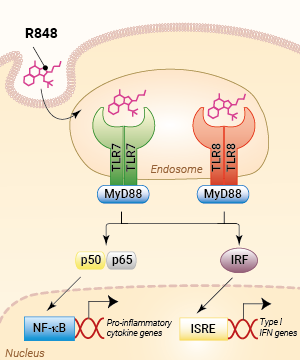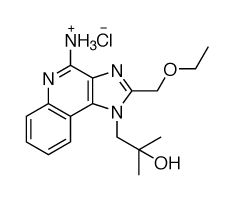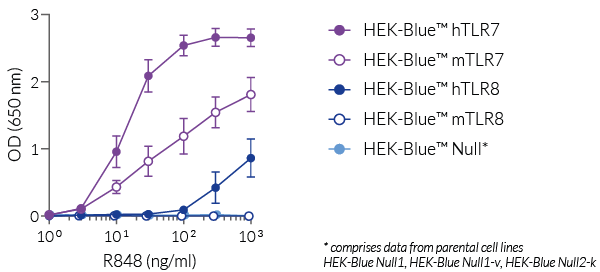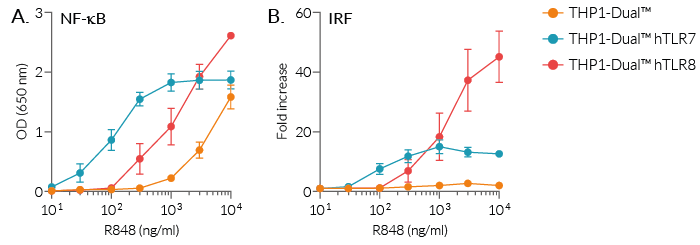R848 (Resiquimod)
| Product | Unit size | Cat. code | Docs. | Qty. | Price | |
|---|---|---|---|---|---|---|
|
R848 (Resiquimod) Imidazoquinoline compound |
Show product |
2 x 500 µg 2 x 5 mg |
tlrl-r848-1
|
|
TLR7/TLR8 Agonist - Imidazoquinoline compound

TLR7/TLR8 activation with R848
 InvivoGen also offers:
InvivoGen also offers:
• TLR reporter cells: HEK293, RAW, THP-1 cells
• TLR research tools: Antibodies, Inhibitors, etc.
R848 (Resiquimod), an imidazoquinoline, is a dual TLR7 and TLR8 synthetic agonist with potent antiviral activity [1-3]. It induces differential TLR7 and/or TLR8 responses in human and murine immune cells. TLR7 and TLR8 are endosomal pattern recognition receptors that play an important role in the antiviral immune response.
Mode of action
R848 (Resiquimod), a low molecular weight synthetic molecule, acts as a selective activating ligand for both TLR7 and TLR8 in humans but only TLR7 in mice. It activates immune cells via the TLR7/TLR8 MyD88-dependent signaling pathway with the subsequent activation of the transcription factors NF-κB and interferon regulatory factor (IRF) [2, 3]. This ultimately leads to the production of pro-inflammatory cytokines and type I interferons.
Unlike other commercially available R848 preparations, InvivoGen's R848 is water soluble, validated for TLR7/TLR8 potency, and tested to ensure the absence of TLR2 or TLR4 contamination.
InvivoGen also offers R848 VacciGrade™, a high-quality pre-clinical grade suited for in vivo studies.
Key features of R848
- Agonist of hTLR7 and hTLR8
- Agonist of mTLR7
- Each lot is highly pure (≥95%) and functionally tested
- High-quality, pre-clinical R848 VacciGrade™ is also available for in vivo studies
![]() Read our review about TLR7 and TLR8.
Read our review about TLR7 and TLR8.
References:
1. Vanwalscappel B. et al., 2018. Toll-like receptor agonist R848 blocks Zika virus replication by inducing the antiviral protein viperin. Virology 522:199-208.
2. Hemmi H. et al., 2002. Small anti-viral compounds activate immune cells via the TLR7 MyD88-dependent signaling pathway. Nat Immunol. 3(2):196-200.
3. Jurk M. et al. 2002. Human TLR7 or TLR8 independently confer responsiveness to the antiviral compound R848. Nat Immunol. 3(6):499.
Specifications
Specificity: Human TLR7, human TLR8, and murine TLR7
Working Concentration: 10 ng - 10 μg/ml
CAS number: 144875-48-9 (free base)
Solubility: 1 mg/ml in water
Formula: C17H22N4O2 • HCl
Molecular weight: 350.8 g/mol
Quality control:
- Purity: ≥95% (UHPLC)
- The activation of human TLR7, human TLR8, and murine TLR7 by R848 has been confirmed using cellular assays.
- The absence of bacterial contamination (e.g. lipoproteins and endotoxins) has been confirmed using HEK-Blue™ hTLR2 and HEK-Blue™ hTLR4 cells.
Contents
R848 (Resiquimod) is provided lyophilized and is available in two quantities:
- tlrl-r848-1: 2 x 500 µg and 1.5 ml of sterile endotoxin-free water
- tlrl-r848-10: 2 x 5 mg and 10 ml of sterile endotoxin-free water
![]() R848 is shipped at room temperature.
R848 is shipped at room temperature.
![]() Upon receipt, it should be stored at 4°C or -20°C.
Upon receipt, it should be stored at 4°C or -20°C.
Details
TLR7 and TLR8:
TLR7 and TLR8 are endosomal pattern recognition receptors that share structural homology [1]. Both receptors are activated by single-stranded RNA (ssRNA) molecules, however, they exhibit different ligand-binding specificities and cellular expression patterns suggesting that they have nonredundant specialized roles.
TLR7 is essentially expressed by plasmacytoid dendritic cells (pDCs) but is also found in B cells and other myeloid cells [2] while TLR8 is highly expressed by myeloid cells and is absent from pDCs and B cells [2].
The endosomal distribution of TLR7 and TLR8 allows them to scan for the presence of microbial RNA in the phagocytic cargo. Their activation leads to NF-κB-, AP1-, and interferon regulatory factor (IRF)-mediated production of type I interferons (IFN-α/β) and pro-inflammatory cytokines [2].
Structural analyses have revealed that both TLR7 and TLR8 possess two binding sites (designated as Site 1 and Site 2) which do not share the same specificities.
Site 1 is highly conserved between TLR7 and TLR8 and binds nucleosides (guanosine (G) for TLR7 and uridine (U) for TLR8) or base analogs. The ligand preference for TLR7 and TLR8 is thus explained by the presence of specific residues in Site 1. Site 1 occupancy allows receptor dimerization and signaling.
Site 2 is less conserved and binds ssRNA with U(U) and U(G) motifs, respectively [3, 4]. Of note, ssRNA-binding to Site 2 is not sufficient for the formation of a signaling-competent TLR dimer but it strongly enhances the binding affinity of Site 1 [3, 4]. Thus, TLR7 and TLR8 appear to sense distinct RNA-degradation products rather than full-length ssRNAs [4].
1. Chuang T.H. & Ulevitch R.J., 2000. Cloning and characterization of a sub-family of human toll-like receptors: hTLR7, hTLR8, and hTLR9. Eur Cytokine Netw, 11:372-8.
2. Georg P. & Sander L.E., 2019. Innate sensors that regulate vaccine responses. Curr. Op. Immunol. 59:31.
3. Zhang Z. et al., 2018. Structural analyses of Toll-like receptor 7 reveal detailed RNA sequence specificity and recognition mechanism of agonistic ligands. Cell Rep. 25:3371.
4. Tanji H. et al., 2015. Toll-like receptor 8 senses degradation products of single-stranded RNA. Nat. Struct. Mol. Biol. 22:109.
Structure of R848 (Resiquimod):









